21 Healthiest Vegetables To Eat According to a Nutritionist in 2025

Eating a balanced diet full of the healthiest vegetables is exciting, flavorful and full of surprises. If you're looking to give your diet a healthy boost, you may be wondering which vegetables pack the biggest nutritional punch and how to incorporate them into your daily meal plans.
It’s essential to be aware of this information because a diet rich in a variety of vegetables can have a positive impact on your health. How does it help, exactly? As The Nutrition Source explains, eating a range of vegetables may help lower blood pressure, support heart health and reduce the risk of certain cancers.
So, what is the healthiest vegetable? The answer depends on your nutritional needs, but nutrient-packed options like kale, spinach and broccoli consistently top the list. Whether you're a seasoned cook or just starting your healthy eating journey, understanding these powerhouse foods is key to a well-rounded diet.
From the leafy greens that adorn our salads to the crunchy roots we snack on, the healthiest vegetables offer more than just flavor — they're brimming with vitamins, minerals and antioxidants, too. To learn more, dive into this nutritionist-reviewed guide to the healthiest vegetables and uncover what makes these plants an essential part of our plates!
Jump to Section
- The 21 Most Healthy Vegetables To Eat
- What Is the Healthiest Vegetable?
- How Do Cooking and Preparation Methods Affect Vegetable Nutrition?
- How We Choose the Healthiest Vegetables To Eat
- Learn To Cook Healthy Meals
The 21 Most Healthy Vegetables To Eat
1. Sweet Potatoes
If you’ve ever wondered, "Are sweet potatoes healthy?", the answer is a resounding yes. Sweet potatoes are a staple among fall produce and are rich in antioxidants such as beta-carotene and vitamin C. These nutrients help combat oxidative stress in the body, making them one of the best foods that relieve stress while supporting overall health.
As explained by WebMD, sweet potatoes are also rich in beta-carotene (which the body converts into vitamin A) and fiber. This means they’re among the healthiest vegetables to support eye and digestive health.
However, as is the case with many of the best vegetables, there are pros and cons to the way you prepare them. Boiled sweet potatoes have a lower glycemic index than those that have been baked or roasted, making them a better choice for those managing blood sugar levels. If you prefer baked or roasted versions, pairing them with protein or healthy fats can help reduce post-meal blood sugar spikes.
Whether baked, mashed or fried, their flavor is a hit in dishes like baked candied sweet potatoes or sweet potato cornbread. Cooking can enhance the bioavailability of beta-carotene, but overcooking may reduce water-soluble vitamins like vitamin C.
Sweet Potatoes Nutritional Info (per 100-gram serving)
- Calories: 86
- Total Fat: 0.1 grams
- Carbohydrates: 20.1 grams (7% DV)
- Dietary Fiber: 3 grams (12% DV)
- Total Sugar: 4.2 grams
- Protein: 1.6 grams (3% DV)
Sweet Potatoes Are a Good Source Of:
- Manganese
- Vitamin A
- Vitamin C
- Vitamin B6

2. Collard Greens
Part of the family of cruciferous vegetables, collard greens contain a rich supply of vitamins A, C and K, as well as calcium. They are also among the healthiest vegetables to include for supporting bone health, according to sources like the Bone Health and Osteoporosis Foundation.
Another benefit of collard greens, as pointed out by the American Academy of Ophthalmology, is that they’re rich in the antioxidants lutein and zeaxanthin, which are essential for the protection of the macula. This area of the eye plays a crucial role in our central vision.
Do note that collard greens contain oxalates, which can contribute to kidney stones and interfere with blood-thinning medications, but issues like these are less common in people with balanced diets who stay well-hydrated. Cooking them also reduces their oxalate levels, and pairing this healthy vegetable with other calcium-rich foods enhances nutrient absorption.
Aside from being a key nutritional player among the healthiest vegetables for multiple reasons, collard greens are also extremely versatile. Whether sautéed or steamed, when included in dishes like Kenya’s sukuma wiki, Brazil’s caldo verde soup or one-pot meals like Instant Pot collard greens, they add a delightfully earthy and slightly sweet flavor.
Collard Greens Nutritional Info (per 100-gram serving)
- Calories: 32
- Total Fat: 0.6 grams (1% DV)
- Carbohydrates: 5.4 grams (2% DV)
- Dietary Fiber: 4 grams (16% DV)
- Total Sugar: 0.5 grams
- Protein: 3 grams (6% DV)
Collard Greens Are a Good Source Of:
- Calcium
- Manganese
- Vitamin K
- Vitamin C
- Vitamin A
3. Brussels Sprouts
Brussels sprouts, small cruciferous vegetables resembling miniature cabbages, are packed with nutrients, making them some of the healthiest vegetables to include in your diet. They shine as one of the healthiest vegetables thanks to their rich content of vitamins C and K, as well as their high amounts of fiber.
Brussels sprouts are also among the healthiest vegetables linked to supporting heart health and reducing inflammation, largely due to an antioxidant known as kaempferol. Although they’re among the healthiest vegetables to eat, their high fiber content can lead to gas or bloating. However, gradually increasing intake and cooking them thoroughly can mitigate this effect.
Steamed or roasted, they work great in many tasty dishes like sautéed Brussels sprouts or Brussels sprouts and bacon.
Brussels Sprouts Nutritional Info (per 100-gram serving)
- Calories: 43
- Total Fat: 0.3 grams
- Carbohydrates: 9 grams (3% DV)
- Dietary Fiber: 3.8 grams (15% DV)
- Total Sugar: 2.2 grams
- Protein: 3.4 grams (7% DV)
Brussels Sprouts Are a Good Source Of:
- Folate
- Manganese
- Vitamin K
- Vitamin C

4. Bell Peppers
Bell peppers, with their vibrant color and sweet flavor, are a staple in many global cuisines and even make excellent healthy snacks when eaten on their own or alongside a healthy dip like black bean hummus. Rich in vitamins A and C and a good source of antioxidants like beta-carotene and lycopene, they are among the healthiest vegetables for supporting eye health, as explained in more detail by Sight Research U.K.
The red color signifies a well-ripened bell pepper that will be sweet, and green or yellow signifies less mature bell peppers that may be more bitter. Also, note that some people may experience mild allergic reactions or digestive discomfort when eating bell peppers. However, cooking them may alleviate these issues.
Whether eaten raw in salads or cooked in dishes like pisto manchego or keto stuffed bell peppers, these versatile and healthy vegetables from the sweet pepper family add both nutrition and flavor to any meal.
Bell Peppers Nutritional Info (per 100-gram serving)
- Calories: 31
- Total Fat: 0.3 grams
- Carbohydrates: 6 grams (2% DV)
- Dietary Fiber: 2.1 grams (8% DV)
- Total Sugar: 4.2 grams
- Protein: 1 gram (2% DV)
Bell Peppers Are a Good Source Of:
- Folate
- Vitamin C
- Vitamin A
- Vitamin B6
5. Spinach
A highly versatile leafy green, spinach is one of the healthiest vegetables to include in your diet when considering how to start eating healthy. It’s packed with iron, calcium and vitamins A and C.
Additionally, spinach supports eye health and may lower blood pressure, according to the American Heart Association, mainly due to its nitrate content. Its combination of nutrients also makes spinach one of the top foods that boost the immune system.
However, its high oxalate levels can hinder calcium and iron absorption, contributing to kidney stones in people who are susceptible to them. Luckily, there’s a way to combat this: Lightly cooking spinach significantly reduces oxalates and enhances iron bioavailability when paired with other vitamin C-rich foods.
Spinach shines when cooked in dishes from India, such as saag paneer or vegan tikka masala, and it can also be eaten raw or even cooked in salads like a wilted spinach salad. If you don’t want to use a single packet of spinach all in one go, but also don’t want it to go off, you can freeze it and throw your frozen spinach straight into the pot or pan for tasty recipes like a spinach omelette.
Spinach Nutritional Info (per 100-gram serving)
- Calories: 23
- Total Fat: 0.4 grams (1% DV)
- Carbohydrates: 3.6 grams (1% DV)
- Dietary Fiber: 2.2 grams (9% DV)
- Total Sugar: 0.4 grams
- Protein: 2.9 grams (6% DV)
Spinach Is a Good Source Of:
- Folate
- Iron
- Magnesium
- Vitamin K
- Vitamin C
- Vitamin A
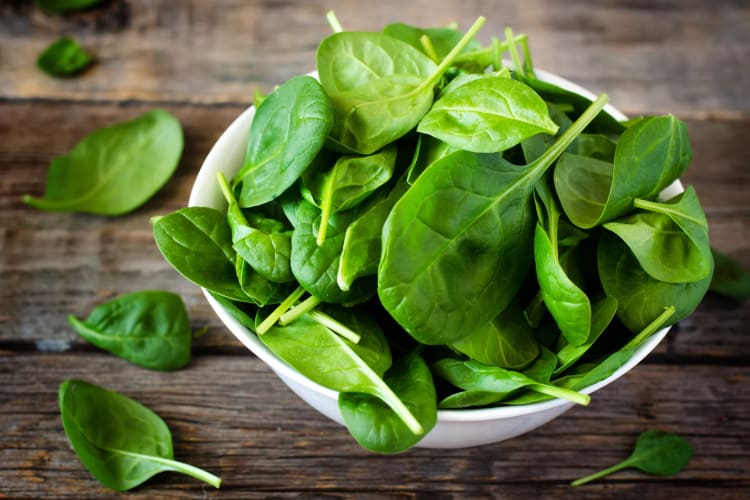
6. Kale
Kale, a nutrient-dense member of the cabbage family, is often labeled a superfood and remains a strong contender among the healthiest vegetables. Rich in fiber and plant compounds, kale may support healthy cholesterol levels and heart function. It is also high in vitamins A, C and K.
Aside from it being one of the healthiest vegetables to include in your diet, kale’s versatility makes it easy to do so, as it’s a popular choice in raw salads, smoothies or baked as chips. It also stars in healthy recipes like white bean and kale soup or a Mediterranean-style lemon kale salad.
Kale Nutritional Info (per 100-gram serving)
- Calories: 49
- Total Fat: 0.9 grams (1% DV)
- Carbohydrates: 8.8 grams (3% DV)
- Dietary Fiber: 3.6 grams (14% DV)
- Total Sugar: 2 grams
- Protein: 4.3 grams (9% DV)
Kale Is a Good Source Of:
- Calcium
- Manganese
- Vitamin K
- Vitamin C
- Vitamin A
7. Broccoli
Its high fiber content may mean you want to add it slowly to your diet if you're not used to foods high in this carbohydrate. If that’s the case and you’re worried that you have too much of this healthy vegetable on hand, you’ll be glad to know that you can store any extra produce in your freezer and pull out the frozen broccoli when you need it again.
Frozen broccoli retains most of the nutrients found in fresh broccoli, so you don’t need to worry about major nutrient losses when cooking from frozen. Broccoli’s versatility additionally makes it a top choice when deciding on the healthiest vegetables to add to your daily meals.
Steaming helps preserve the most nutrients compared with other common cooking methods, but eating it raw is also a healthy option. Broccoli also works great in many more complex recipes, adding flavor and nutrition to dishes like keto broccoli casserole or stir-fried shrimp and broccoli.
Broccoli Nutritional Info (per 100-gram serving)
- Calories: 35
- Total Fat: 0.4 grams (1% DV)
- Carbohydrates: 6.6 grams (2% DV)
- Dietary Fiber: 2.6 grams (10% DV)
- Total Sugar: 1.7 grams
- Protein: 2.8 grams (6% DV)
Broccoli Is a Good Source Of:
- Folate
- Vitamin K
- Vitamin C
- Vitamin A

8. Watercress
A leafy green aquatic plant, watercress boasts a distinct peppery flavor and an impressive nutritional profile. According to MedicineNet, it ranks among the healthiest vegetables for its potential heart-health benefits and its role in supporting bone and eye health.
Also packed with vitamins A, C and K, it’s a powerhouse of antioxidants. However, the high vitamin K content of watercress can interfere with blood-thinning medications, so it’s always best to consult with your healthcare provider if concerned.
Best enjoyed raw in salads or blended into smoothies, you’ll also find this healthy vegetable in traditional dishes, such as watercress soup from Vietnam and Chinese watercress salad.
Watercress Nutritional Info (per 100-gram serving)
- Calories: 11
- Total Fat: 0.1 grams
- Carbohydrates: 1.3 grams
- Dietary Fiber: 0.5 grams (2% DV)
- Total Sugar: 0.2 grams
- Protein: 2.3 grams (5% DV)
Watercress Is a Good Source Of:
- Calcium
- Vitamin K
- Vitamin C
- Vitamin A
9. Cauliflower
Cauliflower often serves as a low-carb substitute for grains, therefore making it one of the healthiest vegetables for keto or other low-carb diets. It is packed with vitamins C and K, and it also contains glucosinolates. As stated by the Linus Pauling Institute, these are plant compounds that support the body’s natural detoxification enzymes.
Cauliflower’s high fiber content can cause bloating, but cooking this healthy vegetable helps reduce these effects while making it easier to digest. Whether roasted or blitzed into “rice,” it’s a staple in dishes enjoyed by people with all taste preferences, but especially those on plant-based and low-carb diets.
If you fall into the latter category, we recommend learning how to rice cauliflower to make dishes like Spanish cauliflower rice and cilantro lime cauliflower rice. Some more of our favorite recipes for those on vegetarian and vegan diets, respectively, are hearty cauliflower au gratin and grilled cauliflower steaks.
Cauliflower Nutritional Info (per 100-gram serving)
- Calories: 25
- Total Fat: 0.3 grams
- Carbohydrates: 5 grams (2% DV)
- Dietary Fiber: 2 grams (8% DV)
- Total Sugar: 1.9 grams
- Protein: 1.9 grams (4% DV)
Cauliflower Is a Good Source Of:
- Folate
- Vitamin B6
- Vitamin C
- Vitamin K

10. Carrots
Celebrated for their high beta-carotene content, carrots are undoubtedly among the healthiest vegetables to eat for maintaining eye and skin health. The body converts beta-carotene into vitamin A, which supports vision, immune function and cell growth. Carrots also provide antioxidants and fiber, which contribute to heart and digestive health.
While excessive consumption can cause carotenemia, eating them in moderation balances these benefits with minimal risk. Cooking carrots enhances beta-carotene absorption but may slightly reduce water-soluble vitamin levels. Even so, they remain one of the healthiest vegetables to eat, regardless of preparation method.
Popular in dishes like Indian carrot halwa or Moroccan carrot salad, they’re equally delicious raw, roasted or diced. We also suggest using them as inspiration to make vegan and vegetarian soup recipes, such as vegan lentil soup, or those with animal products, such as Maryland crab soup.
Carrots Nutritional Info (per 100-gram serving)
- Calories: 41
- Total Fat: 0.2 grams
- Carbohydrates: 9.6 grams (3% DV)
- Dietary Fiber: 2.8 grams (11% DV)
- Total Sugar: 4.7 grams
- Protein: 0.9 grams (2% DV)
Carrots Are a Good Source Of:
- Potassium
- Vitamin K
- Vitamin C
- Vitamin A
11. Beets
Known for their earthy flavor and deep red hue, beets are among the healthiest vegetables for supporting liver function. Other health benefits of adding beets to your diet include lowering blood pressure (due to their high nitrate content) and protecting cells from inflammation. However, their high oxalate levels may contribute to kidney stones, so moderation is key.
Cooking enhances their natural sweetness, making them a comforting addition to dishes like Eastern European borscht or Mediterranean beet salad with feta. Luckily, if you’re an amateur chef, learning how to cook beets is a straightforward process, as it can be done in the oven, on the stove or in an Instant Pot.
Whether baked in dishes like roasted beets and carrots or steamed in Instant Pot recipes like Instant Pot beets, they are a colorful and nutritious addition to any diet. Some of our other favorite ways to use beets include pickling and adding them to a salad, or juicing them with other healthy vegetables when we need a quick nutritional boost.
Beets Nutritional Info (per 100-gram serving)
- Calories: 43
- Total Fat: 0.2 grams
- Carbohydrates: 9.6 grams (3% DV)
- Dietary Fiber: 2.8 grams (11% DV)
- Total Sugar: 6.8 grams
- Protein: 1.6 grams (3% DV)
Beets Are a Good Source Of:
- Folate
- Manganese
- Potassium
- Iron

12. Asparagus
Asparagus earns its place among the healthiest vegetables for its tender texture, unique flavor and exceptional nutritional profile.
Packed with folate and vitamins A, C, E and K, this popular ingredient for many spring recipes supports overall health, particularly by aiding digestion through its fiber content and acting as a natural diuretic. As stated by the Cleveland Clinic, asparagus may help support liver and kidney function, promote healthy blood pressure and aid digestion.
Despite the unfortunate side effect of causing an odor in urine due to asparagusic acid, this is harmless, and cooking methods like steaming or grilling can help manage its intensity. Whether you use a fresh version or opt for frozen asparagus, recipes like air-fryer asparagus with hollandaise sauce or Italian-style asparagus wrapped in prosciutto showcase this healthy vegetable's culinary adaptability, while cooking enhances its digestibility.
Asparagus Nutritional Info (per 100-gram serving)
- Calories: 20
- Total Fat: 0.1 grams
- Carbohydrates: 3.9 grams (1% DV)
- Dietary Fiber: 2.1 grams (8% DV)
- Total Sugar: 1.9 grams
- Protein: 2.2 grams (4% DV)
Asparagus Is a Good Source Of:
- Folate
- Vitamin K
- Vitamin C
- Vitamin A
13. Green Peas
Sweet and tender, green peas are more than just a simple side dish — they're one of the healthiest vegetables thanks to their high protein content and a wealth of essential nutrients, including vitamins A, C and K. Although their richness in fiber can cause digestive issues, introducing green peas gradually into your diet and cooking them thoroughly can ease digestion.
In terms of cooking method, light steaming or boiling are good options, with both retaining their vibrant color and nutrients. Traditional recipes, such as pea salad, French pea soup or classic mushy peas from the U.K., bring out their best qualities and showcase how versatile these little green vegetables can be.
Green Peas Nutritional Info (per 100-gram serving)
- Calories: 81
- Total Fat: 0.4 grams (1% DV)
- Carbohydrates: 14.5 grams (5% DV)
- Dietary Fiber: 5.7 grams (23% DV)
- Total Sugar: 5.7 grams
- Protein: 5.4 grams (11% DV)
Green Peas Are a Good Source Of:
- Folate
- Manganese
- Vitamin K
- Vitamin C
- Vitamin A

14. Radishes
Radishes, with their crisp texture and peppery bite, are a standout addition to the roster of healthiest vegetables. They’re rich in vitamin C and potassium, and as Verywell Fit explains, they also support digestion and help combat inflammation. While some individuals might experience digestive discomfort from eating radishes raw, cooking or pairing them with digestion-friendly foods can reduce this effect.
As far as recipes go, Mexican pickled radishes or spicy Korean tofu soup with daikon (Japanese radishes) bring out their vibrant flavor, making them a top choice among the healthiest vegetables to incorporate into globally-inspired recipes.
Radishes Nutritional Info (per 100-gram serving)
- Calories: 16
- Total Fat: 0.1 grams
- Carbohydrates: 3.4 grams (1% DV)
- Dietary Fiber: 1.6 grams (6% DV)
- Total Sugar: 1.9 grams
- Protein: 0.7 grams (1% DV)
Radishes Are a Good Source Of:
- Folate
- Potassium
- Vitamin C
15. Artichokes
Artichokes, available in green or purple varieties, are among the healthiest vegetables and are widely found fresh, canned or jarred. Offering gut-supporting benefits, this thistle is packed with dietary fiber — notably prebiotic inulin — and delivers vitamins K and C along with folate, magnesium and potassium. Artichokes also provide antioxidant polyphenols like cynarin and chlorogenic acid that support overall health.
While some people may notice digestive discomfort from inulin, cooking softens the fibers and can make artichokes easier to tolerate.
Marinating or canning preserves nutrients and adds convenience, making them ideal for dishes like Roman-style braised artichokes, hot artichoke dip or bright salads. Whether steamed with lemon, folded into stews or stuffed and baked, this healthy vegetable is as versatile as it is nutritious.
Artichokes Nutritional Info (per 100-gram serving)
- Calories: 47
- Total Fat: 0.2 grams
- Carbohydrates: 10.5 grams (4% DV)
- Dietary Fiber: 5.4 grams (21% DV)
- Total Sugar: 1 gram
- Protein: 3.3 grams (7% DV)
Artichokes Are a Good Source Of:
- Folate
- Magnesium
- Potassium
- Vitamin C
- Vitamin K
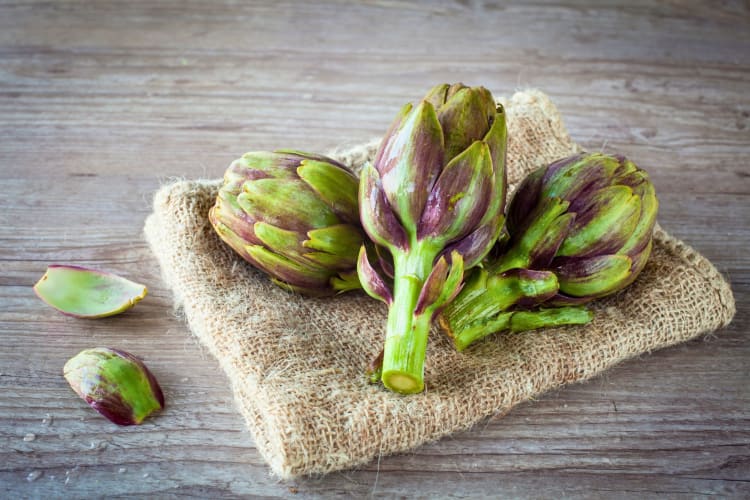
16. Eggplant
Eggplant’s spongy texture and mild flavor have earned it a place as a popular ingredient in Mediterranean and other global cuisines, and thanks to its impressive nutrient profile, it’s also worthy of a spot among the healthiest vegetables.
This nightshade is high in fiber and potassium, and its antioxidants may help protect cells from damage and support healthy blood sugar balance, according to WebMD. Though solanine in eggplant can cause digestive discomfort, thorough cooking neutralizes this compound while enhancing its flavor.
Eggplant proves its versatility in countless dishes cooked worldwide, from Japanese eggplant with miso and Thai eggplant curry to Middle Eastern baba ghanoush and Italian-inspired vegan eggplant Parmesan. Its flavor adapts beautifully, taking on rich, smoky or savory notes depending on the preparation.
Eggplant Nutritional Info (per 100-gram serving)
- Calories: 25
- Total Fat: 0.2 grams
- Carbohydrates: 5.9 grams (2% DV)
- Dietary Fiber: 3 grams (12% DV)
- Total Sugar: 3.5 grams
- Protein: 1 gram (2% DV)
Eggplant Is a Good Source Of:
- Manganese
- Potassium
17. Zucchini
Zucchini, one of a few summer vegetables in the squash family, is celebrated as one of the healthiest vegetables for its vitamin C and potassium content. As noted by Verywell Health, it aids digestion, combats inflammation and balances gut bacteria, making zucchini a gentle yet powerful addition to any diet.
While consuming zucchini raw in large amounts may cause minor digestive discomfort, cooking resolves this issue. As it’s so versatile, we love using this healthy vegetable in a variety of dishes, ranging from healthy appetizers, like air-fryer zucchini fries, to delectable desserts like banana zucchini bread.
Whether you’re using raw or frozen zucchini, its adaptability extends from spiralizing into noodles to roasting and stuffing, keeping it among the healthiest vegetables for a nutritious and diverse diet.
Zucchini Nutritional Info (per 100-gram serving)
- Calories: 17
- Total Fat: 0.3 grams
- Carbohydrates: 3.1 grams (1% DV)
- Dietary Fiber: 1 gram (4% DV)
- Total Sugar: 2.5 grams
- Protein: 1.2 grams (2% DV)
Zucchini Is a Good Source Of:
- Potassium
- Vitamin C
- Vitamin B6

18. Mushrooms
With their umami-rich flavor and unique antioxidants, mushrooms are some of the most nutritious vegetables available (although technically classified as fungi instead of vegetables). Their fiber and B vitamin content support digestion and energy production, while ergothioneine, a unique antioxidant, helps protect against oxidative stress.
Plus, according to the National Cancer Institute, certain mushrooms contain bioactive compounds such as beta-glucans that can help modulate immune function and may play a role in reducing certain disease risks. To avoid the risks of toxic varieties, stick to cultivated mushrooms or expertly identified wild ones.
If you’ve ever traveled the world, you've likely realized that mushrooms are a beloved ingredient in global kitchens. Whether sautéed in wild mushroom risotto or simmered in mushroom ragout, these fungi bring both depth and nutrition. Cooking not only enhances their flavor but also improves their digestibility.
Mushrooms Nutritional Info (per 100-gram serving)
- Calories: 22
- Total Fat: 0.3 grams
- Carbohydrates: 3.3 grams (1% DV)
- Dietary Fiber: 1 gram (4% DV)
- Total Sugar: 2 grams
- Protein: 3.1 grams (6% DV)
Mushrooms Are a Good Source Of:
- Riboflavin
- Niacin
- Copper
- Pantothenic Acid
19. Onions
A staple in kitchens worldwide, onions are celebrated as one of the healthiest vegetables for their high fiber and B vitamin content. They contain an antioxidant that supports cardiovascular health and reduces oxidative stress, and according to the National Onion Association, they also promote gut health.
Though some may experience digestive discomfort or heartburn from onions, cooking can mellow their pungency and make them easier to digest. Used in a range of dishes, from Instant Pot recipes like Instant Pot French onion soup to Indonesian onion sambal, this healthy vegetable can elevate a variety of meals, whether caramelized, sauteéd or raw.
Onions Nutritional Info (per 100-gram serving)
- Calories: 40
- Total Fat: 0.1 grams
- Carbohydrates: 9.3 grams (3% DV)
- Dietary Fiber: 1.7 grams (7% DV)
- Total Sugar: 4.2 grams
- Protein: 1.1 grams (2% DV)
Onions Are a Good Source Of:
- Folate
- Vitamin C

20. Garlic
Garlic, with its bold aroma and powerful antioxidants, stands out as one of the most flavor-packed healthy vegetables for supporting cardiovascular health. Other benefits of garlic, as stated by Riverside Health, include its potential to support immune function, promote gut health and aid digestion.
While consuming garlic raw can cause digestive discomfort, cooking tones down its intensity and highlights its sweetness, making it not only one of the healthiest vegetables but also one of the most delicious. Traditional dishes like Italian aglio e olio or Asian-inspired honey garlic glazed salmon rely on its transformative properties, proving garlic’s essential role in culinary and health traditions alike.
Finally, you didn’t think we’d forget to mention the highly beloved garlic bread, did you? If you’ve only ever eaten store-bought varieties and never pondered how to make garlic bread at home, it’s a lot easier than you think, and oftentimes, much healthier. Plus, you can make it in the oven, air fryer or toaster, all of which we cover in our helpful guide.
Garlic Nutritional Info (per 100-gram serving)
- Calories: 149
- Total Fat: 0.5 grams (1% DV)
- Carbohydrates: 33.1 grams (12% DV)
- Dietary Fiber: 2.1 grams (8% DV)
- Total Sugar: 1 gram
- Protein: 6.4 grams (13% DV)
Garlic Is a Good Source Of:
- Manganese
- Vitamin C
- Vitamin B6
21. Swiss Chard
Known for its vibrant colors and nutrient density, Swiss chard is one of the healthiest vegetables to add to your diet for multiple reasons. Packed with fiber and potassium, it offers anti-inflammatory benefits and supports bone health. Additionally, as stated by the Royal Horticultural Society, eating this healthy vegetable is associated with supporting a healthy weight and reducing risk factors linked to heart disease and diabetes.
Cooking enhances the digestibility of Swiss chard while preserving its wealth of nutrients, making it a must-have for colorful, nutrient-packed meals. Traditional Spanish dishes like estofado de pollo or Swiss chard pie from Greece showcase its culinary range, solidifying its place among the healthiest vegetables that are equally as delicious.
Swiss Chard Nutritional Info (per 100-gram serving)
- Calories: 19
- Total Fat: 0.2 grams
- Carbohydrates: 3.7 grams (1% DV)
- Dietary Fiber: 1.6 grams (6% DV)
- Total Sugar: 1.1 grams
- Protein: 1.8 grams (4% DV)
Swiss Chard Is a Good Source Of:
- Magnesium
- Potassium
- Vitamin K
- Vitamin C
- Vitamin A
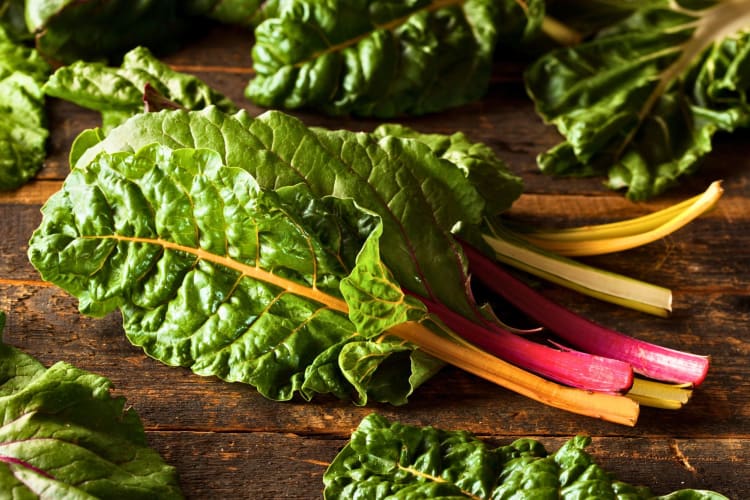
What Is the Healthiest Vegetable?
Choosing the healthiest vegetables isn't as straightforward as picking a single "superstar." Instead, it depends on what your body needs and the kind of meals you love to prepare.
Some of the healthiest vegetables, like carrots and sweet potatoes, boast high levels of beta-carotene, while spinach and kale are packed with iron and antioxidants. If you're watching calories, watercress and zucchini are excellent low-calorie options. Need fiber? Then Brussels sprouts and broccoli can always be relied on.
A great philosophy of nutrition to follow draws inspiration from South Africa's traditional Seven Colors meal, which emphasizes having a rainbow of food on your plate. By focusing on as many different colors as possible, you’re more likely to create meals that are nutritionally balanced. Vibrantly colored vegetables like Swiss chard or beetroot often signal a high nutritional profile, making them well worth including in your diet.
However, diversity is key, and each vegetable brings unique benefits to the table. Incorporating variety not only boosts your health but also adds contrasting flavors, excitement and balance to your meals. The Seven Colors philosophy also aligns with eating seasonally, as each season brings its own colorful bounty of the most nutritious vegetables, ensuring freshness, flavor and sustainability on your plate.
To help you pick the healthiest veggies based on your nutritional preferences, the following guide lists the vitamins and minerals to look out for, and which are the best sources to find them in:
Vitamin K
- Swiss Chard
- Kale
- Spinach
- Collard Greens
- Brussels Sprouts
Vitamin C
- Bell Peppers (Red)
- Kale
- Broccoli
- Brussels Sprouts
- Cauliflower
Vitamin A
- Sweet Potatoes
- Carrots
- Kale
- Spinach
- Collard Greens
Vitamin B6
- Garlic
- Sweet Potatoes
- Cauliflower
- Zucchini
Folate
- Spinach
- Asparagus
- Beets
- Green Peas
- Broccoli
Manganese
- Kale
- Garlic
- Green Peas
- Beets
- Collard Greens
Potassium
- Swiss Chard
- Beets
- Carrots
- Zucchini
- Radishes

How Do Cooking and Preparation Methods Affect Vegetable Nutrition?
As we’ve alluded to above, even the most nutritious vegetables have their vitamin and mineral content affected by the way they’re prepared. If you’re looking to retain as much nutritional value as possible, use the following guidelines to make more informed decisions about healthy vegetables:
- Fresh: Wherever possible, use fresh vegetables in your meals, as these generally contain the highest nutritional value.
- Fermented: The process of fermentation not only helps retain most of the nutrients but also adds a healthy amount of probiotics to the mix.
- Boiled: Certain vegetables lose their nutrients when boiled, so choose steaming over boiling where possible.
- Roasted: The absorption of fat-soluble nutrients, like beta-carotene, is boosted, but water-soluble vitamins, such as vitamin C, are reduced.
- Steamed: When comparing cooking methods, steaming is the most advantageous, as it helps retain nutrients the best. In fact, with certain vegetables, such as broccoli, it actually increases the availability of polyphenols and antioxidants.
- Frozen: Nutrition remains mostly the same during freezing, but beta-carotene will be lower in certain vegetables.
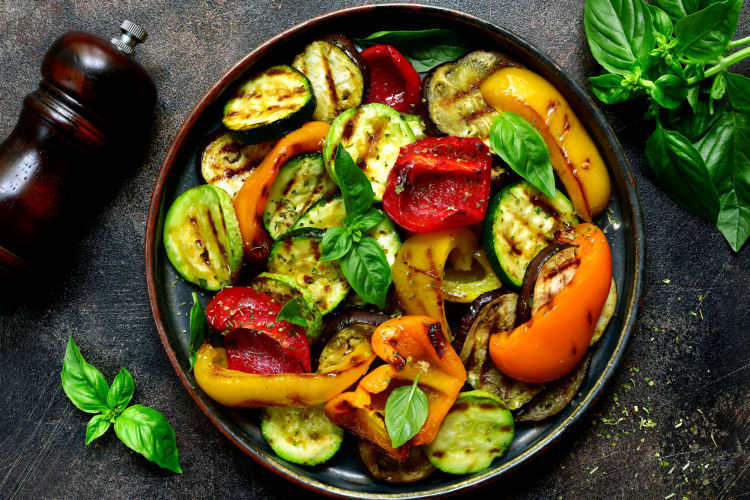
How We Choose the Healthiest Vegetables To Eat
Creating a list of the healthiest vegetables may seem like an impossible task, as they’re generally all healthy. But there are still important nutritional factors to consider, with some coming out on top as being the healthiest vegetables to eat.
Fortunately, the team at Cozymeal is up to the task of identifying the most nutritious vegetables to add to your diet. Thanks to more than a decade of experience in the culinary industry, we’ve accumulated the knowledge to create insightful guides on various food-related topics, including nutrition guides such as this one.
When creating this type of content, we recognize that it’s essential to ensure guides are factually accurate and as comprehensive as possible, which is why we do thorough research and enlist the help of experts. For this guide on the healthiest vegetables, we considered the views of nutritionists, as well as the chefs we connect people with on a daily basis.
Finally, we kept the following criteria in mind when choosing the healthiest vegetables to include:
- Nutrient Density: Our list of the healthiest vegetables focuses on those that are packed with the most essential vitamins, minerals and antioxidants.
- Health Benefits: We created our guide on the healthiest vegetables with a focus on those that offer numerous health benefits, such as improving heart health and digestion, while also reducing the risk of diseases like cancer.
- Versatility: We believe that it’s important to not only highlight the health benefits of the healthiest vegetables, but also their ability to be cooked in a variety of meals.
- Accessibility: Finally, we considered the healthiest vegetables based on their availability worldwide.
Registered Nutritionist Review
Our goal in creating this list of the healthiest vegetables was to help people make better and more informed choices. To ensure we achieve this, we enlisted the help of Jessica O'Shea, a Registered Nutritionist (ANutr) with the Association for Nutrition.
Not only does she have a BSc (Hons) in Food, Nutrition, and Wellbeing, as well as an MSc in Human Nutrition, but she’s also passionate about helping others plan the healthiest diet for their needs.
Her expertise helped us create a guide to the healthiest vegetables that can be incorporated into various diets and enhance people’s overall health.
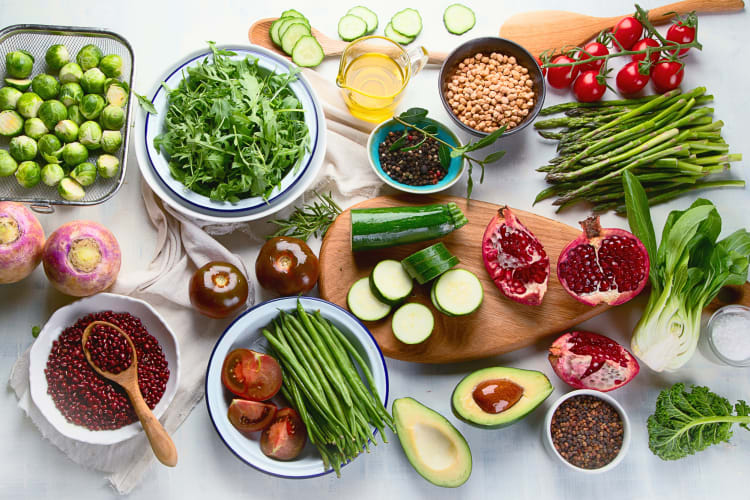
Learn To Cook Healthy Meals
Do you want to master the art of creating delicious dishes with the healthiest vegetables? Then consider exploring online healthy cooking classes, as these interactive experiences provide valuable techniques for turning everyday vegetables into mouthwatering meals.
From perfecting the balance of flavors to learning creative ways to use seasonal produce, learning virtually from the comfort of your home or joining cooking classes near you can make healthy eating an exciting adventure.
Incorporating the healthiest vegetables into your diet isn’t just about nutrition; it’s about discovering the joy of cooking with fresh, wholesome ingredients. With expert guidance via a cooking class and a bit of practice, you can elevate simple vegetables into meals that are as good for your health as they are for your taste buds.

Integrating the healthiest vegetables into your diet is an essential step toward a balanced and nutritious lifestyle. Whether you're blending spinach into smoothies, roasting sweet potatoes or sautéing Brussels sprouts, there's no shortage of ways to enjoy these natural powerhouses.
By embracing their variety, you'll reap the benefits of improved health while treating your palate to new and exciting flavors. The healthiest vegetables are more than just ingredients — they’re the cornerstone of a fulfilling diet.
For even more ways to explore your favorite foods, check out other experiences happening on Cozymeal.



FOOD FOR THOUGHT?
Join the conversation.